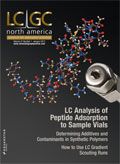Market Profile: Gas Chromatography
In gas chromatography (GC), the sample vapor passes through the column and separates into its components - a separation that is governed by the distribution between the mobile and stationary phases.
In gas chromatography (GC), the sample vapor passes through the column and separates into its components — a separation that is governed by the distribution between the mobile and stationary phases. The degree of separation between the sample and the stationary phase is determined by flow rate, the nature of the stationary phase, the surface area exposed to the carrier gas, and the column temperature. As a result, while solvent changes are commonly used in high performance liquid chromatography (HPLC), GC uses temperature changes to improve separations. As the individual components emerge from the column, the detector obtains a signal.

2011 GC regional distribution.
The GC columns may be of two types: packed or capillary. Packed columns can accept a larger injection volume, but capillary columns have better separating power. There are a number of different detectors available as a function of the analyte constituent. These include thermal and electrolytic conductivity, flame ionization, electron capture, nitrogen–phosphorus, photoionization, mass selective, infrared, and atomic emission detectors.
GC is very well established in the U.S., Western Europe, and Japan, where the installed base is extremely large. In fact, North America and Europe combined account for nearly 60% of the worldwide GC demand. However, lower-end GC systems have become ubiquitous in areas such as Eastern Europe, China, India, and Latin America.
The foregoing data were extracted and adapted from SDi's recently published 12th edition. For more information, contact Glenn Cudiamat, VP of Research Services, Strategic Directions International, Inc., 6242 Westchester Parkway, Suite 100, Los Angeles, CA 90045, (310) 641-4982, fax: (310) 641-8851, e-mail: cudiamat@strategic-directions.com.

Regulatory Deadlines and Supply Chain Challenges Take Center Stage in Nitrosamine Discussion
April 10th 2025During an LCGC International peer exchange, Aloka Srinivasan, Mayank Bhanti, and Amber Burch discussed the regulatory deadlines and supply chain challenges that come with nitrosamine analysis.
Top Execs from Agilent, Waters, and Bruker Take the Stage at J.P. Morgan Healthcare Conference
January 16th 2025The 43rd Annual Healthcare J.P. Morgan Healthcare Conference kicked off in San Francisco earlier this week. Here’s what top executives from Agilent, Bruker, and Waters, discussed during the event.

.png&w=3840&q=75)

.png&w=3840&q=75)



.png&w=3840&q=75)



.png&w=3840&q=75)







